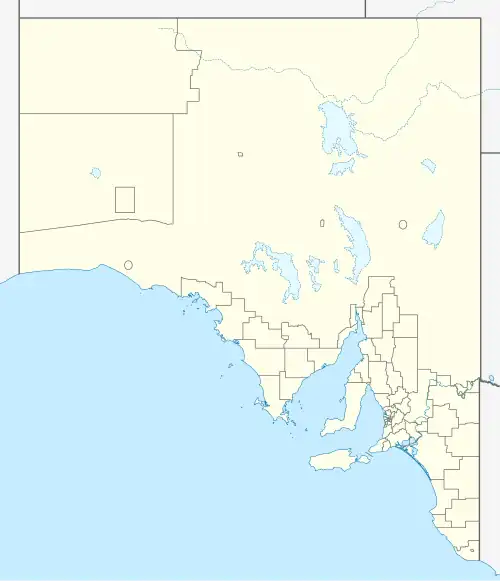Puttapa

Puttapa or Puttapa Station is a pastoral lease that operates as a sheep station, located in the Flinders Ranges region of South Australia, to the south of Leigh Creek. There are heritage-listed sites of considerable significance on the property, in particular the Ajax Mine Fossil Reef, which is under consideration for UNESCO World Heritage status.
History
The area that is covered by Puttapa was once part of a much larger lease taken up by John Haimes in 1854, which eventually became Beltana Station.[1][2] The area was known as the Puttapa paddock and was eventually sold to Steven Lock in 1911 and became Puttapa Station.[1]
Len Ragless purchased the lease in 1936, and it remained in the Ragless family until it was put on the market in early 2025 by Len's grandson, Graham Ragless. The property has kept some cattle in the past, and harvested feral goats, but it has been primarily a sheep station. It transitioned from Merino sheep, bred mainly for their wool, to Dorpers and Australian White sheep, which are bred for their meat.[2]
The land occupying the extent of the Puttapa pastoral lease was gazetted by the Government of South Australia as a locality in April 2013 under the name Puttapa.[3]
The property was sold in May 2025.[4][5]
Description
Puttapa Station is a pastoral lease run as a sheep station,[2] located around to the north of the historic town of Beltana[6] and south of Leigh Creek, South Australia.[2] The property covers 31,000 ha (77,000 acres) and is primarily grazing land.[2]
It also has tourist facilities, in the form of converted shearers' quarters and tracks for motorbikes and four-wheel drives.[2]
Heritage listings
As of August 2025, Puttapa Station contains the following heritage-listed sites:
- Ajax Mine Fossil Reef was listed as a State Heritage Place in the SA Heritage Register on 28 August 2014, as a designated place of palaeontological and geological significance.[7][8] As of 2022 Puttapa is the location of one of seven sites in the Flinders Ranges under consideration for UNESCO World Heritage status,[9] listed as Ajax Hill.[10]
- Copper King Copper and Ochre Mine was listed as a State Heritage Place in the SA Heritage Register on 23 November 1989 for its significance as a mine, being one of four major European (non-Indigenous) coloured pigment sites in South Australia, reflecting the transition from copper to pigment production around 1900.[11]
See also
References
- ^ a b "Puttapa Station". Flinders Range Research. Retrieved 14 November 2015.
- ^ a b c d e f Dulhunty, Kylie (12 February 2025). "End of an era: Historic Puttapa Station set to sell after 89 years in one family". MarketPulse. Retrieved 4 August 2025.
- ^ "Search result for "Puttapa (LOCB)" (Record no SA0067178) with the following layers selected - "Suburbs and Localities" and " Place names (gazetteer)"". Property Location Browser. Government of South Australia. Archived from the original on 12 October 2016. Retrieved 2 June 2016.
- ^ "'Puttapa Station' Puttapa Road, PUTTAPA, SA 5730". Ray White Rural South Australia. 29 May 2025. Retrieved 4 August 2025.
- ^ McLennan, Chris (29 May 2025). "Station's buyers inherit ancient key to the planet's earliest life". Stock Journal. Retrieved 4 August 2025.
- ^ "Ajax Mine, Puttapa, Pastoral Unincorporated Area, South Australia, Australia". Mindat.org. Retrieved 3 August 2025.
- ^ "[Ajax Mine Fossil Reef], Zinc Mine Road PUTTAPA". SA Heritage Places database search. Government of South Australia. 2 February 2017. Archived from the original on 3 August 2025. Retrieved 3 August 2025.
- ^ South Australian Heritage Council (8 August 2014). "Summary of state heritage place: Ajax Mine Fossil Reef PLACE NO.: 26390" (PDF). pp. 1–12. Retrieved 3 August 2025.
- ^ "Ajax Limestone Archaeocyath fossils". Flinders Ranges Field Naturalists. 29 July 2022. Retrieved 3 August 2025.
- ^ "Flinders Ranges". World Heritage Convention. UNESCO. Retrieved 4 August 2025.
- ^ "[Copper King Copper & Ochre Mine], Zinc Mine Road PUTTAPA". SA Heritage Places database search. Government of South Australia. 2 February 2017. Archived from the original on 4 August 2025. Retrieved 3 August 2025.